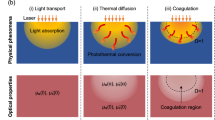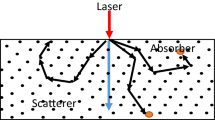Abstract
The theory of selective photothermolysis (SP) is used in many fields of laser surgery and medicine. As several parameters and a number of complicated photothermal interactions are involved in SP, numerical simulations have been providing an important and effective way in SP studies. However, with different photothermal models of SP, simulated results differ considerably. In addition, insufficient attention has been paid to tissue pressure variation during SP in these models, so that vessel rupture and other clinical phenomena cannot be explained. A novel photothermal model of SP was proposed using a Monte Carlo method to simulate the laser transport in the tissue, a heat transfer equation with dynamically changing vaporization temperature to calculate the temperature distribution, and the Arrhenius equation to predict the thermal damage. A factor of trapped vaporized tissue water k was introduced to describe the effects on tissue pressure, temperature, and other related parameters. It was shown that the simulation results are affected significantly by k. Temperature and thermal damage volume are almost identical, respectively, to those obtained with models with vaporization at 100°C and models without vaporization when k = 0 and 1, while thermal damage volume is close to that obtained with models of vaporization at 110°C and 130°C, respectively, when k = 0.022 and k = 0.18. To some extent, the current models without vaporization and models with vaporization at constant temperature can be regarded as special cases at specific situations of this new photothermal model of SP. In addition, more descriptive simulation results, such as temperature, thermal damage, and pressure, are accessible with this model, although the accuracy depends on the value of k, the estimation of which is planned as future work.






Similar content being viewed by others
Reference
Anderson RR, Parrish JA (1983) Selective photothermolysis: precise microsurgery by selective absorption of pulsed radiation. Science 220:524–527
Altshuler GB, Anderson RR, Manstein D et al (2001) Extended theory of selective photothermolysis. Lasers Surg Med 29:416–432
Manstein D, Herron GS, Sink RK et al (2004) Fractional photothermolysis: a new concept for cutaneous remodeling using microscopic patterns of thermal injury. Lasers Surg Med 34:426–438
Lucassen GW, Svaasand LO, Verkruysse W, van Gemert MJC (1995) Laser energy threshold for thermal vascular injury in a port-wine stain skin model. Lasers Med Sci 10:231–234
Smithies DJ, Butler PH (1995) Modeling the distribution of laser light in port-wine stains with the Monte Carlo method. Phys Med Biol 40:701–731
Svaasand LO, Fiskerstrand EJ, Kopstad G, Norvang LT, Svaasand EK, Nelson JS et al (1995) Therapeutic response during pulsed laser treatment of port-wine stains: dependence on vessel diameter and depth in dermis. Lasers Med Sci 10:235–243
Lucassen GW, Verkruysse W, Keijzer M, van Gemert MJC (1996) Light distributions in a port-wine stain model containing multiple cylindrical and curved blood vessels. Lasers Surg Med 18:345–357
Sturesson C, Andersson-Engels S (1996) Mathematical modeling of dynamic cooling and pre-heating, used to increase the depth of selective damage to blood vessels in laser treatment of port-wine stains. Phys Med Biol 41:413–428
Mirkov M, Sherr EA, Sierra RA et al (2006) Analytical modeling of laser pulse heating of embedded biological targets: an application to cutaneous vascular lesions. J Appl Phys 99:114071
Pfefer TJ, Smithies DJ, Milner TE, van Gemert MJC, Nelson JS, Welch AJ (2000) Bioheat transfer analysis of cryogen spray cooling during laser treatment of port-wine stains. Lasers Surg Med 26:145–157
Tunnell JW, Wang LH, Anvari B (2003) Optimum pulse duration and radiant exposure for vascular laser therapy of dark port-wine skin: a theoretical study. Appl Opt 42(7):1367–1378
Dai TH, Pikkula BM, Wang LHV, Anvari B (2004) Comparison of human skin opto-thermal response to near-infrared and visible laser irradiations: a theoretical investigation. Phys Med Biol 49:4861–4877
Jia WC, Aguilar G, Verkruysse W, Franco W, Nelson JS (2006) Improvement of port-wine stain laser therapy by skin preheating prior to cryogen spray cooling: A numerical simulation. Lasers Surg Med 38:155–162
Shafirstein G, Bäumler W, Lapidoth M, Ferguson S, North PE, Warner M (2004) A new mathematical approach to the diffusion approximation theory for selective photothermolysis modeling and its implication in laser treatment of port-wine stains. Lasers Surg Med 34:335–347
Zhang R, Verkruysse W, Aguilar G, Nelson JS (2005) Comparison of diffusion approximation and Monte Carlo based finite element models for simulating thermal response to laser irradiation in discrete vessels. Phys Med Biol 50:4075–4086
Black JF, Wade N, Barton JK (2005) Mechanistic comparison of blood undergoing laser photocoagulation at 532 and 1064 nm. Lasers Surg Med 36:155–165
Shafirstein G, Buckmiller LM, Warner M, Bäumler W (2007) Mathematical modeling of selective photothermolysis to aid the treatment of vascular malformations and hemangioma with pulsed dye laser. Lasers Med Sci 22:111–118
Jia WC, Choi B, Franco W, Lotfi J, Majaron B, Aguilar G, Nelson JS (2007) Treatment of cutaneous vascular lesions using multiple-intermittent cryogen spurts and two-wavelength laser pulses: numerical and animal studies. Lasers Surg Med 39:494–503
Franco W, Childers M, Nelson JS, Aguilar G (2007) Laser surgery of port-wine stains using local vacuum pressure: changes in calculated energy deposition (Part II). Lasers Surg Med 39:118–127
Heger M, Beek JF, Moldovan NI et al (2005) Towards optimization of selective photothermolysis: prothrombotic pharmaceutical agents as potential adjuvants in laser treatment of port-wine stains—a theoretical study. Thromb Haemost 93:242–256
Suthamjariya K, Farinelli WA, Koh W, Anderson RR (2004) Mechanisms of microvascular response to laser pulses. J Investig Dermatol 122:518–525
Jacques SL (1998) Skin Optics. http://omlc.ogi.edu/news/jan98/skinoptics.html
Jiang SC, Zhang XX (2005) Effects of dynamic changes of tissue properties during laser-induced interstitial thermotherapy (LITT). Lasers Med Sci 19(4):197–202
Wang LH, Jacques SL, Zheng LQ (1995) MCML-Monte Carlo modeling of light transport in multi-layered tissues. Comput Methods Progr Biomed 47:131–146
Wang LH, Jacques SL, Zheng LQ (1997) CONV-convolution for responses to a finite diameter photon beam incident on multi-layered tissues. Comput Methods Progr Biomed 54:141–150
London RA, Glinsky ME, Zimmerman GB et al (1997) Laser-tissue interaction modeling with LATIS. Appl Opt 36:9068–9074
Francis AD (1990) Physical properties of tissue. Academic Press, London
Majaron B, Plestenjak P, Lukac M (1999) Thermo-mechanical laser ablation of soft biological tissue: modeling the micro-explosions. Appl Phys B 69:71–80
Tunnell JW (2002) Selective vascular injury during cutaneous laser therapy. Rice University, Houston, Texas, USA
Pikkula BM (2003) Optimization of cryogen spray cooling: increasing epidermal protection during cutaneous laser procedures. Rice University, Houston, Texas, USA
Zhang JZ, Shen YG, Zhang XX (2009) A dynamic photothermal model of CO2 laser tissue ablation. Lasers Med Sci 24(3):329–338
Mordon SM, Rochon P, Dhelin G, Lesage JC (2005) Dynamics of temperature dependent modifications of blood in the near-infrared. Lasers Surg Med 37:301–307
Pikkula BM, Chang DW, Nelson JS, Anvari B (2005) Comparison of 585 and 595 nm laser-induced vascular response of normal in vivo human skin. Lasers Surg Med 36:117–123
Ross EV, Domankevitz Y (2005) Laser treatment of leg veins: physical mechanisms and theoretical considerations. Lasers Surg Med 36:105–116
Wen X, Tuchin VV, Luo QM, Zhu D (2009) Controlling the scattering of intralipid by using optical clearing agents. Phys Med Biol 54:6917–6930
Ramachandran T, Sreenivasan K, Sivakumar R (1996) Water vaporization from heated tissue: an in vitro study by differential scanning calorimetry. Lasers Surg Med 19:413–415
Acknowledgements
This work was supported by the Specialized Research Fund for the Doctoral Program of Higher Education of China (Grant No. 20070003101) and Key Laboratory of Optoelectronic Science and Technology for Medicine (Fujian Normal University) of the Ministry of Education of China (Grant No. JYG0819).
Author information
Authors and Affiliations
Corresponding author
Rights and permissions
About this article
Cite this article
Zhang, J.Z., Zhang, X.X. & Audette, M. A photothermal model of selective photothermolysis with dynamically changing vaporization temperature. Lasers Med Sci 26, 633–640 (2011). https://doi.org/10.1007/s10103-011-0949-3
Received:
Accepted:
Published:
Issue Date:
DOI: https://doi.org/10.1007/s10103-011-0949-3




